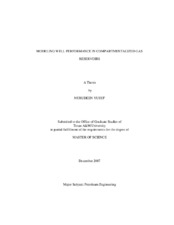| dc.contributor.advisor | Wattenbarger, R.A. | |
| dc.creator | Yusuf, Nurudeen | |
| dc.date.accessioned | 2010-01-15T00:03:13Z | |
| dc.date.accessioned | 2010-01-16T00:24:28Z | |
| dc.date.available | 2010-01-15T00:03:13Z | |
| dc.date.available | 2010-01-16T00:24:28Z | |
| dc.date.created | 2007-12 | |
| dc.date.issued | 2009-05-15 | |
| dc.identifier.uri | https://hdl.handle.net/1969.1/ETD-TAMU-2107 | |
| dc.description.abstract | Predicting the performance of wells in compartmentalized reservoirs can be quite
challenging to most conventional reservoir engineering tools. The purpose of this
research is to develop a Compartmentalized Gas Depletion Model that applies not only
to conventional consolidated reservoirs (with constant formation compressibility) but
also to unconsolidated reservoirs (with variable formation compressibility) by including
geomechanics, permeability deterioration and compartmentalization to estimate the
OGIP and performance characteristics of each compartment in such reservoirs given
production data.
A geomechanics model was developed using available correlation in the industry
to estimate variable pore volume compressibility, reservoir compaction and permeability
reduction. The geomechanics calculations were combined with gas material balance
equation and pseudo-steady state equation and the model was used to predict well
performance.
Simulated production data from a conventional gas Simulator was used for
consolidated reservoir cases while synthetic data (generated by the model using known parameters) was used for unconsolidated reservoir cases. In both cases, the
Compartmentalized Depletion Model was used to analyze data, and estimate the OGIP
and Jg of each compartment in a compartmentalized gas reservoir and predict the
subsequent reservoir performance. The analysis was done by history-matching gas rate
with the model using an optimization technique.
The model gave satisfactory results with both consolidated and unconsolidated
reservoirs for single and multiple reservoir layers. It was demonstrated that for
unconsolidated reservoirs, reduction in permeability and reservoir compaction could be
very significant especially for unconsolidated gas reservoirs with large pay thickness and
large depletion pressure. | en |
| dc.format.medium | electronic | en |
| dc.format.mimetype | application/pdf | |
| dc.language.iso | en_US | |
| dc.relation.uri | https://hdl.handle.net/1969.1/85871 | |
| dc.subject | Compartmentalized | en |
| dc.subject | Geomechanics | en |
| dc.subject | Compaction | en |
| dc.subject | Deep Gas wells | en |
| dc.title | Modeling well performance in compartmentalized gas reservoirs | en |
| dc.type | Book | en |
| dc.type | Thesis | en |
| thesis.degree.department | Petroleum Engineering | en |
| thesis.degree.discipline | Petroleum Engineering | en |
| thesis.degree.grantor | Texas A&M University | en |
| thesis.degree.name | Master of Science | en |
| thesis.degree.level | Masters | en |
| dc.contributor.committeeMember | Efendiev, Yalchin | |
| dc.contributor.committeeMember | Maggard, J.B. | |
| dc.type.genre | Electronic Thesis | en |
| dc.type.material | text | en |
| dc.format.digitalOrigin | born digital | en |


